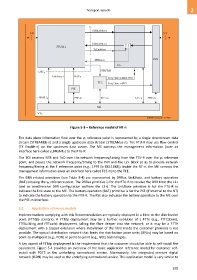Page 689 - 5G Basics - Core Network Aspects
P. 689
Transport aspects 2
Figure 5-3 – Reference model of NT-n
The data plane information flow over the γR reference point is represented by a single downstream data
stream (STREAMds-n) and a single upstream data stream (STREAMus-n). The FTU-R may use flow control
(TX Enable-n) on the upstream data steam. The ME conveys the management information (over an
interface here called γ_MGMTR) to the FTU-R.
The TCE receives NTR and ToD over the network frequency/timing from the FTU-R over the γR reference
point, and passes the network frequency/timing to the PHY and the L2+ block so as to provide network
frequency/timing at the T reference point (e.g., 1PPS [b-IEEE1588]). Inside the NT-n, the ME conveys the
management information (over an interface here called TCE-m) to the TCE.
The DRA related primitives (see Table 8-4) are represented by DRRus, LinkState, and battery operation
(BAT) crossing the γR reference point. The DRRus primitive is for the FTU-R to receive the DRR from the L2+
(and to send/receive DRR configuration to/from the L2+). The LinkState primitive is for the FTU-R to
indicate the link state to the ME. The battery-operation (BAT) primitive is for the PSE (if internal to the NT)
to indicate the battery operation to the FTU-R. The PSE also indicates the battery operation to the ME over
the PSE-m interface.
5.2 Application reference models
Implementations complying with this Recommendation are typically deployed in a fibre to the-distribution
point (FTTdp) scenario. A FTTdp deployment may be a further evolution of a FTTx (e.g., FTTCabinet,
FTTBuilding and FTTcurb) deployment, taking the fibre deeper into the network, or it may be a FTTH
deployment with a copper extension where installation of the fibre inside the customer premises is not
possible. The optical distribution network that feeds the distribution point units (DPUs) may be based on
point-to-multipoint (e.g., PON) or point-to-point (e.g., GbE) technologies.
A key aspect of FTTdp deployment is the requirement that the customer should be able to self-install the
equipment. Figure 5-4 provides an overview of the basic application reference model for customer self-
install with POTS as the underlying narrowband service. Alternatively, the integrated services digital
network (ISDN) may be used as the underlying narrowband service. This application model is very similar to
679

